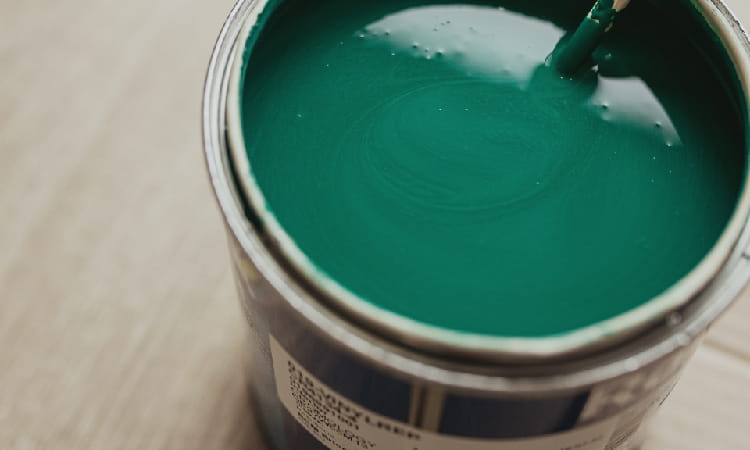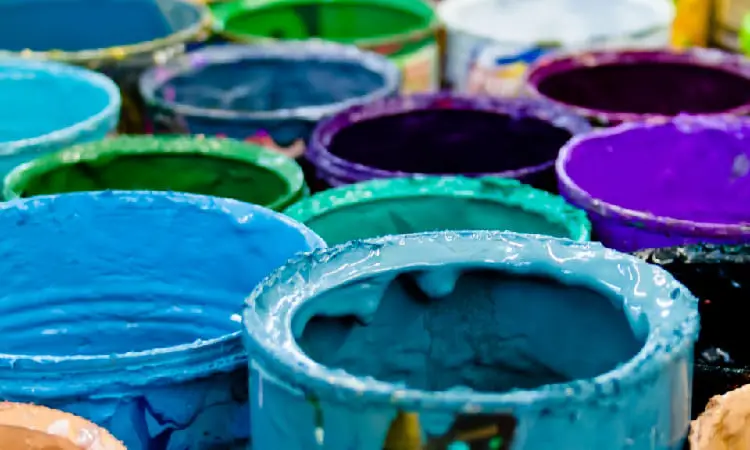There is no doubt that colors are fun. Parties and celebrations without colors can be a little boring.
You might have seen some people in the US decorate their faces with the American flag on the fourth of July to commemorate the country’s independence.
But what types of paint can you use on your skin? Is acrylic paint safe for the skin?
Acrylic paints are not advisable for skin contact. Many ingredients may cause skin irritations, including xylene, ethyl acetate, quaternary ammonium compounds, benzene, methylene chloride, phenol, and many others.
Exposing your skin to these elements may cause redness and other skin allergies. Non-toxic acrylic paints are not exempt as they can also cause skin reactions.
I will elaborate on the various ingredients in the paint that can cause irritations. I will also cover the common side effects of using acrylic paint on the skin.
Furthermore, I will explore different types of paint that are okay for body use. Plus, I will feature some of the best body and face paints you can consider trying. Read on and enjoy!

Paint Ingredients that Can Harm Your Skin
Multiple ingredients make up the paint, including pigments, binders, solvents, and other additives.
Apart from these, other chemicals are also added to the formula to improve the paint’s performance.
Please look at the common chemicals paint manufacturers add to their products that can potentially harm your skin.
Xylene
Xylene is a typical solvent you will find in paint. Paint manufacturers sometimes use this product as a co-solvent to help thin the paint. Is this chemical dangerous?
Yes, it is! You can read this public health statement by the Agency for Toxic Substances and Disease Registry (ATSDR), which provides details on the effects of the substance on the human body.
Xylene will irritate your skin, eyes, nose, and throat. Your body absorbs the substance through your skin.
In other words, the toxins can enter your body when your skin gets in contact with xylene. Moreover, when it gets into your lungs, it may cause more serious issues.
Ethyl Acetate
Another solvent you will usually find in paints is ethyl acetate. This colorless substance can act as a hardener for the paint.
Like most other solvents, this can also affect your health negatively. When this comes in contact with your skin, you may experience some skin irritations and allergies.
Additionally, frequent skin exposure can cause your skin to dry or crack. So, you should avoid it if you can.
This substance can potentially cause more serious problems like difficulty in breathing. It can even affect your kidney and liver in the long run.
Quaternary Ammonium Compounds
Also known as quats, these compounds are in paints as surfactants or disinfectants. These additives added to the formula give the paint a longer life span.
It does serve a good purpose. However, it also can cause irritations when you let a quats-containing paint sit on your skin for a little while.
Rashes are a common skin problem when you expose yourself to this substance.
Some people may experience skin asthma. Your skin can turn red and itchy. On top of that, it may show painful scaly patches.
Benzene
Most, if not all, paints on the shelves contain benzene. This solvent keeps the paint liquid. The paint can get thick and hard to apply without this substance.
Like xylene, it can also enter your body when it touches your skin. Therefore, you should take extra precautions not to expose yourself to this substance.
What skin harm can it cause? This solvent can cause several skin conditions, including erythema, edema, and blistering.
It can also give your skin an uncomfortable burning feeling. Frequent skin exposure can lead to even more serious issues.
Methylene Chloride
Methylene chloride is a highly controlled substance. However, some paints may still contain this hazardous element.
This colorless and sweet-smelling solvent can cause skin problems. You will likely experience skin redness and other irritations.
In some severe scenarios, this substance can burn your skin.
This substance does not only irritate your skin. It can also irritate your eyes, nose, and throat.
Thus, it is important that if you handle a product that possibly contains methylene chloride, you wear a protective suit.
Inhalation of the fumes may also lead to serious respiratory and lung problems.
Phenol
Phenol can act as an anti-oxidant or disinfectant in the paint. This additive helps prolong the life of the paint.
The only problem is the harm that it brings. It is very strong and can penetrate your skin quickly, causing cell damage and gangrene.
You must not expose your skin to this substance whenever possible. This substance is so dangerous that it can cause imminent death.
If you think you got exposed to phenol, I suggest that you seek medical advice on how you can decontaminate yourself.
There could be many more ingredients that paints contain that can harm the skin. I cannot mention all of those in this article.
What is important is that you know these harmful substances could be in the paint you use. Therefore, you should avoid skin contact at all times.
Is it Safe to Use Acrylic Paint on Your Skin?

I remember back in the days when my brother and I played with the acrylic paint our dad left open.
We painted our faces with the ninja turtle designs and continued playing. Our mom immediately washed our faces and cleaned up the paint when she noticed what we had done.
But it was a little late. Our faces had already turned red and were swelling.
That was my first-hand experience with the effect of acrylic paint on the skin. Even if the acrylic paint label says it is “non-toxic,” it is still not safe for use on your skin.
Acrylic paints contain many harmful additives that could cause irritations to your skin, eyes, nose, and throat.
Some irritations and allergies may happen when you expose your skin to acrylic paint. These include rashes, skin discoloration, redness, blistering, and itchiness.
It is important to note that not all people react similarly to paint toxins. Thus, if your friend tells you it is safe because he did not experience any irritations, do not be swayed easily.
How Long Can You Have Acrylic Paint on Your Skin?
Again, acrylic paint is not safe for the skin. Your skin can develop allergies and irritations.
The paint toxins may also get into your body through skin absorption. So, for me, there is no safe period in that you can let acrylic paint sit on your skin.
If you happen to expose your skin to acrylic paint, ensure to wash it off immediately. The paint toxins may cause instantaneous skin reactions.
Don’t be caught off-guard by thinking it is okay to have acrylic paint on your skin for a few minutes or hours.
If the acrylic paint gets into your skin, you can combine oil and rubbing alcohol to clean it.
You can do a follow-up wash using water and soap to remove all the paint residues on the skin.
Potential Negative Effects of Acrylic Paint Used on Skin
The side effects of acrylic paint on the skin can vary from person to person. Some people may also not experience any irritations or allergies.
However, the most common conditions recorded include rashes, skin discoloration, redness, blistering, and itchiness. Sometimes, skin exposure to acrylic paint may also cause a burning sensation.
The side effect is dependent on the solvents or chemicals in the paint. Acrylic paint may contain various harmful ingredients that I have mentioned above, such as xylene, ethyl acetate, and quaternary ammonium compounds.
You can refer to this section to review how these hazardous chemicals harm the skin.
How to Remove Acrylic Paint from Skin

Now, let’s talk about how you can remove acrylic paint from your skin. The removal process may vary depending on the condition of the paint on your skin.
A soap and water combination might do the trick if the paint is still fresh and wet. However, if the paint has dried on the skin, you might need other approaches to remove it.
Some people use baby oil paired with warm water. Others use rubbing alcohol or acetone.
I will discuss how to use these methods to remove acrylic paint from the skin below.
Soap and Water (for fresh paint)
If you accidentally spill acrylic paint on your skin, immediately head to your faucet and wash the paint spot directly with soap and water.
The paint easily washes away when it is fresh. If there are hard to remove paint residues, you can use the help of warm water to loosen the paint’s contact with the skin.
You can use any mild soap available for this process. However, dish soaps may perform better as they contain elements that can help wash all paint residues.
Dry your skin and re-examine the exposed skin to see if you need to do the process again.
Baby Oil
Baby oil is another product you can use to eliminate the acrylic paint on your skin. First, you must soften the paint’s contact with the skin by washing it with soap and warm water.
When I say warm, I mean bearable warm, which does not burn your skin. Otherwise, it will be another problem.
After warm-washing the paint spot, rub it with baby oil. Apply a little bit of force as necessary to peel off the paint.
You may use a cloth, cotton, or even your fingers to rub the oil directly on the spot. When the paint peels, rinse it with soap and water. Repeat the process as necessary.
Rubbing Alcohol
Rubbing alcohol is a ‘go-to’ product for me when cleaning dirt off my skin.
It is because this solution contains antibacterial properties. You can also use it to clean your skin from paint. The process is quite similar to using baby oil.
You start by washing the painted skin with soap and warm water. Then, grab a rubbing alcohol-wet cotton ball directly on the paint spot until it loosens.
When the paint softens, rinse the area again with soap and water. Repeat as needed.
Acetone
Acetone can also help remove acrylic paint from the skin like it removes nail polish.
Always start the process by washing the area with soap and warm water. You can gently scrape the paint off if it is too thick for rubbing.
When the paint spot is ready, wet a cloth with acetone and place it over the spot for a few minutes until it loses contact with the skin.
When the paint softens, you can do a slight rubbing. Then, rinse the area again with soap and water. This method may not be the best for you if you are highly reactive to harsh solvents.
What Types of Paint You Can Use for Face and Body Art
If acrylic paint is not very friendly to the skin, there are other types of paint that you can use for face and body art.
These include water-based body paint, alcohol-based body paint, silicone makeup, latex body paint, metallic body paint, cream-based character body paint, and hybrid airbrush body paint.
Water-based Body Paint
Skin-friendly water-based paints comply with stringent manufacturing guidelines. You can use this paint on your body without causing serious allergies.
When the party is over, you don’t need to worry about how to get it off your skin because it easily strips off with any oil products.
You can use a sponge or an airbrush to apply the water-based paint to your body.
The only trouble you may have with this paint is that your art can be affected if you are the type who sweats a lot. The flowing of the sweat may wash off the paint.
Alcohol-Based Body Paint
This paint is the opposite of water-based body paint in terms of susceptibility to sweat. Body painters prefer to use this type because it is sweatproof.
It means that your body painting could last longer. However, it is not safe from possible damage. When you rub the paint, it strips off easily.
Some people may still develop irritations with this type of paint. There are also some safety considerations before applying this paint to your body.
If you have pre-existing skin conditions, it may worsen them due to the alcohol content. Waxing or shaving your skin before your body painting fun is also not ideal.
Silicone Makeup
Silicone makeup is an expensive type of body paint. It is not ideal for whole-body painting.
However, body painting artists usually have them in their kits as they help create fine details. There are also many color options for artists when they shop for this paint.
Face painting usually uses this silicone makeup. It is ideal because the canvass area is small.
The paint design on your neighbor’s face during Halloween could be silicone paint. Additionally, people prefer this type of paint due to its durability.
Latex Body Paint
If you are up to full body painting, latex body paint is the most suitable and affordable option. This paint is the type of paint that most cosplay artists use for the costume.
There are also not so many allergies associated with this paint. Of course, conduct a skin test before applying it all over your body. It is not fun to deal with irritations.
Unlike other body paints, latex body paint sits over your skin.
It may affect your body temperature as the skin pores are covered. In saying so, it is important to keep yourself hydrated at all times to avoid any complications.
Metallic Body Paint

You may have seen body art featuring metallic effects or glittering designs.
These designs use metallic body paint. Paint experts warn that artists must use these paints with extra precautions. The ingredients in the paint can cause severe allergies.
Before purchasing this type of paint, you must read the product description.
Some manufacturers sell non-FDA-approved products. Do not compromise your health. Safety should be your top priority.
Cream-based Character Body Paint
This product is another type of makeup paint that is highly water/sweatproof.
This paint is your best bet if your event involves water, like a pool party. Due to its efficiency, most body paint artists have this in their painting kits.
The only challenge with this paint is the removal process. You can’t remove it with just water and soap. Oil-based based products may not work fully in removing this paint.
You can ask art shop crews for the most effective cream-based character body paint remover.
3 Best Paints for Face and Body Art
If you are still reading this part of the article, it means you are looking into doing some face or body paint job.
I can help you further by presenting the best products you can try.
1. Best Overall: Mehron Makeup Paradise Makeup AQ Face & Body Paint
This face and body paint from Mehron is water-activated. It boasts anti-fade/crack qualities.
Furthermore, this product also features skin-friendly ingredients, including aloe vera extracts, vitamin E, cucumber, lemon grass, and avocado.
The 1.4 oz of this paint is capable of covering your full body. Now, that is quite a promise.
It is worth the price because it features premium ingredients to ensure skin safety.
Mehron has also been in the business for more than 90 years. With this reputation, you can be almost certain that its product is trustworthy.
The company claims to be the leader in the industry and the most preferred brand by artists.
Those who have tried the Mehron Makeup Paradise Makeup AQ Face & Body Paint express that it does live up to its promise.
Some users report that the paint compliments well with the skin regardless of the color. Other users love the ease of application.
2. Easiest to Wash: Midnight Glo Black Light Face and Body Paint (Set of 8 Bottles 0.75 oz. Each)
This Midnight Glo product is a glowing paint with a premium creamy texture.
It comes in various color options, including pink, red, orange, yellow, green, blue, purple, and white. It boasts a non-toxic formula, which is safer for your skin.
One of the best qualities of the paint is its capability to detach from the skin with just soap and water.
Easy washing means you can get rid of paint residues more quicker.
It further means that you can wash away the paint toxins more quicker.
This product is getting good ratings and reviews on Amazon. Some users have tried this paint on their kids’ faces for parties and were happy with the result.
The paint did not cause any skin irritations. Other users are extremely satisfied with the vibrancy of the paint’s colors.
3. Best Budget: Dress-Up-America Face Paint Crayons – With Artbook & Designs
If you love painting kids’ faces during kiddie parties, this paint is the most affordable paint crayon you can try.
It comes in various colors, which allows you to produce more creative designs. This paint is also easy to apply and wash with warm water.
It features non-toxic ingredients, guaranteeing that it is safe for kid skin. The vibrant colors could add more life to your kiddie parties and events.
The manufacturer also guarantees premium ingredients in the paint. That is yet, another assurance of safety.
User reviews reveal that this paint did not show any negative reactions, even to kids known to have sensitive skin.
That there is an edge! Other users like the paint ideas included in the package. They think it makes the painting job easier.
FAQs: Acrylic Paint on Skin
1. Is watercolor paint safe for babies?
Baby skins can be overly sensitive. However, you don’t also want them left out during events that feature face paints.
Watercolor paint may not be safe for babies. Although the product may indicate that it is “safe for kids,” you cannot discount the fact that it contains ingredients that your baby’s skin may not be able to handle.
You must avoid painting your kid’s skin if you can. The fun may not be worth the risk.
However, if you want to put some skin art using watercolor paint, I suggest you do some testing first. You can put a small amount of paint on the kid’s skin and see if it creates any allergies or irritations.
2. Is tempera paint safe for the skin?
Tempera is generally considered safe for the skin. It is also ideal as it is affordable. The noon-toxic powder can be a good material to create face or body art.
However, there might still be some people who have overly sensitive skin that may still experience some irritations.
Although tempera is safe, you must not let it sit on your skin for a long time. If you do so, the paint will stain your skin, and removing it may take a while.
Therefore, you should remove tempera from your skin after a few minutes. Wearing it for hours may lead to staining.
3. Is Crayola paint safe for baby skin?
Crayola paint is safe for your baby’s skin. Kids can get dirty with this paint because all Crayola paint on the market is certified safe and non-toxic.
Yay! So, if you have kids who love art, you can allow them to be creative with this product.
There is no hassle in cleaning up the paint mess because it easily washes away with water. Plus, your kids can use the paint indoors.
It doesn’t require good ventilation. Of course, you still need to ensure your kids are not ingesting the paint. Even if it is non-toxic, it may still cause tummy issues for your lovely ones.
4. What paint can I use for the baby handprint?
Washable tempera paint is ideal for a baby handprint. This non-toxic paint is safe for your baby’s skin.
This material is also quite affordable. Therefore, you can buy ample supplies of this paint for your toddlers to enjoy without spending much.
Another option is Crayola paint. This paint is generally considered safe for the baby’s skin. You can let your baby play with this paint without worrying that they might get skin rashes and other irritations.
This paint is non-toxic and very easy to wash with water. Supervision may still be necessary to ensure your child is not eating the paint.
Conclusion
Acrylic paint is not advisable for skin use. If you love to create body or face art using paint, you can consider commercial face and body paint.
These paints follow stringent measures to ensure safety. Even so, they may still cause allergies and irritations for some people.
If you are looking for the type of paint to use for your kids’ skin, you can look into using tempera or Crayola paint.
These paints are generally safe for kids. They do not contain hazardous toxins that could harm your little one’s skin.





